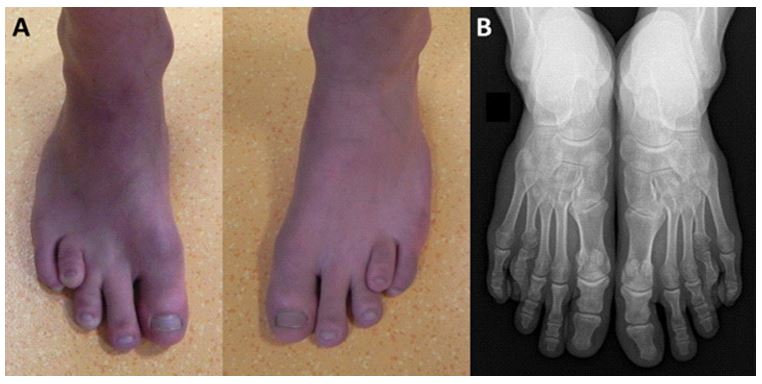Clinical Image - Volume 3 - Issue 1
Spondylo-epiphyseal dysplasia, Czech type
Médéric Jeanne1,2*
1Genetics Department, University Hospital of Tours, Tours, France.
2UMR 1253, iBrain, University of Tours, INSERM, Tours, France.
Received Date : Feb 01, 2023
Accepted Date : Feb 24, 2023
Published Date: Feb 27, 2023
Copyright:© Médéric Jeanne 2023
*Corresponding Author : Médéric Jeanne, Genetics Department, University Hospital of Tours, Tours, France
Email: mederic.jeanne@univ-tours.fr
DOI: Doi.org/10.55920/2771-019X/1383
Clinical Image
A 20-year-old man presented to the clinic for early-onset arthropathy starting by the age of 13. On physical examination he had brachymetatarsia of the fourth toes (panel A). He had normal stature and had no cognitive impairment or dysmorphic features. Phosphocalcic metabolism investigations were normal. Besides knees and hip osteoarthritis and mild platyspondyly, radiographs showed bilateral fourth metacarpal shortening (panel B), leading to the diagnosis of Czech Dysplasia, which was confirmed by genetic analysis. First described in 1993, this condition is a collagen disorder resulting from a recurrent mutation (c.823C>T, p.Arg275Cys) in the COL2A1 gene. The association of early-onset osteoarthritis with brachymetatarsia of the fourth toes is characteristic of Czech dysplasia and can be further distinguished from the other type 2 collagenopathies on the absence of short stature and of ophthalmological features. Czech dysplasia must also be distinguished from Albright’s hereditary osteodystrophy (AHO) by the early-onset osteoarthritis which is absent in AHO. Patients with Czech dysplasia do not need specific treatment but usually require early management of the osteoarthritis. Hearing should be monitored as progressive hearing loss has been described.


